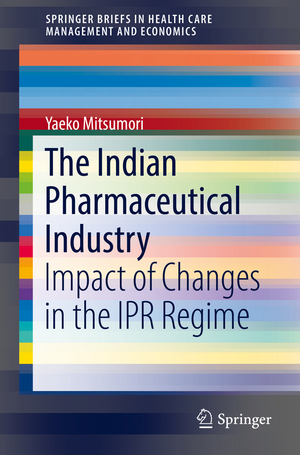The Indian Pharmaceutical Industry: Impact of Changes in the IPR Regime: SpringerBriefs in Health Care Management and Economics
Autor Yaeko Mitsumorien Limba Engleză Paperback – 10 iul 2018
This study also covers recent developments in India regarding intellectual property rights and the pharmaceutical industry. One is India’s very first compulsory license granted to an Indian pharmaceutical company, Natco, against the large German pharmaceutical firm Bayer; and the second is the Supreme Court decision on Novartis’ Gleevec. The study analyzes the fundamental problems that caused these two events: access to medicine and gaps in the concept of intellectual property in the pharmaceutical industry. As possible solutions to these fundamental issues, this book explores the ideas of voluntary licensing and tiered pricing.
Preț: 350.89 lei
Nou
Puncte Express: 526
Preț estimativ în valută:
67.15€ • 71.80$ • 55.98£
67.15€ • 71.80$ • 55.98£
Carte tipărită la comandă
Livrare economică 14-19 aprilie
Preluare comenzi: 021 569.72.76
Specificații
ISBN-13: 9789811067891
ISBN-10: 9811067899
Pagini: 120
Ilustrații: VII, 120 p. 36 illus., 28 illus. in color.
Dimensiuni: 155 x 235 mm
Ediția:1st ed. 2018
Editura: Springer Nature Singapore
Colecția Springer
Seria SpringerBriefs in Health Care Management and Economics
Locul publicării:Singapore, Singapore
ISBN-10: 9811067899
Pagini: 120
Ilustrații: VII, 120 p. 36 illus., 28 illus. in color.
Dimensiuni: 155 x 235 mm
Ediția:1st ed. 2018
Editura: Springer Nature Singapore
Colecția Springer
Seria SpringerBriefs in Health Care Management and Economics
Locul publicării:Singapore, Singapore
Cuprins
Chapter 1: Introduction.- Chapter 2: Historical Background and Current Status of Indian Pharmaceutical Industry and Indian Patents Regime.- Chapter 3: Research Subject and Methodology.- Chapter 4: Analysis of Preceding Studies.- Chapter 5: Analysis of Indian Pharmaceutical Industry Indicators-Data Analysis.- Chapter 6: Analysis of Patents Act Enforcement After Introduction of Product Patents.- Chapter 7: Applicability of Section 3 (d).- Chapter 8: Conclusions and Future Challenges.
Caracteristici
Explains that the Indian pharmaceutical industry is No. 4 in the world in volume and its development is being carefully watched Explains why the Indian pharmaceutical industry successfully expanded even after the introduction of product patents Provides information on the unique article “3d” in the Indian Patent Act and how it allows the Indian Patent Office to reject some patents that have been granted in the rest of the world








